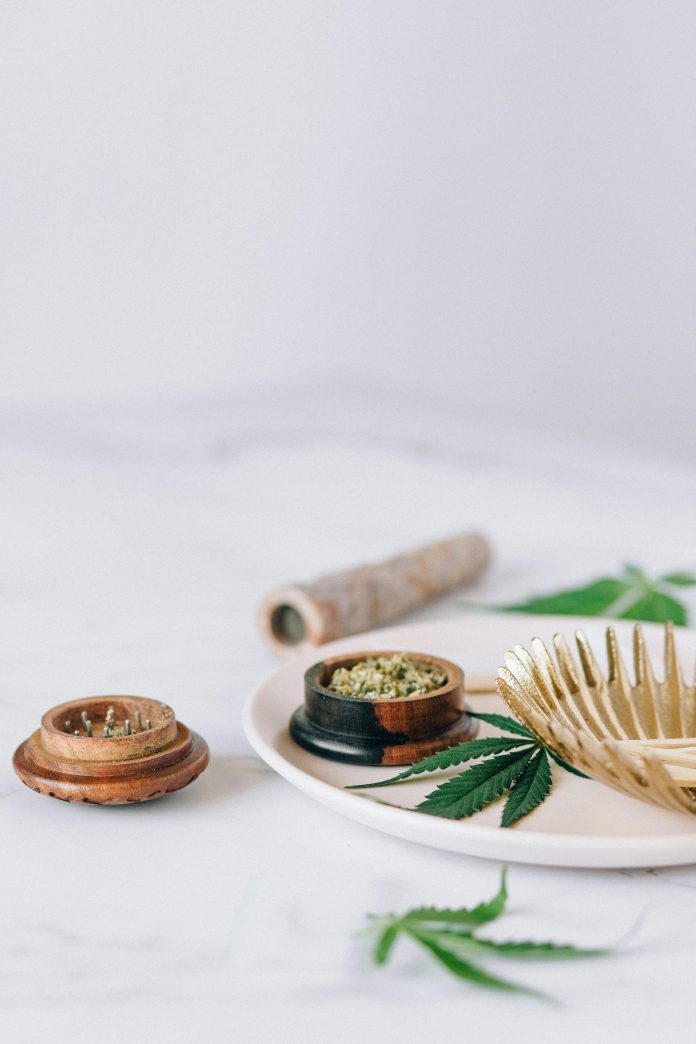Short for cannabidiphorol, CBD-P is one of many cannabinoids found in recent years.
And while deemed a synthetic cannabinoid for some time, a team of Italian scientists isolated it for the first time from the cannabis plant in 2019. At which point, they then learned it was instead a phytocannabinoid that naturally develops in cannabis plants.
It was then when these scientists and pioneers of the industry gave it its name – CBDP!
Them isolating it was made possible with cutting-edge tech, like HRMS (high-resolution mass spectrometry) and HPLC (high-performance liquid chromatography); specialized techniques that enabled these scientists to learn CBD-P is the heptyl homologue of the cannabinoid known as CBD. This means CBD/CBD-P have a similar chemical make up!
It also goes by other names, such as CBD-C7/CBD-heptyl, yet it is most known as CBDP.
The only thing that sets CBD/CBD-P apart is their molecular structure, as while CBD has a pentyl side chain of five carbon atoms, CBD-P has one consisting of seven. Another thing that sets CBD-P apart is it is a partially-synthetic compound as it is lab-made and created.
This said, how is CBD-P made? And what steps do scientists follow when making it? It is a pretty simple process, actually, as it is made via a technique known as isomerization. If you are unsure what this is, this is when CBD isolate (the purest form of CBD) is turned into a new and stronger compound via a chemical reaction that alters the molecular structure.
The result? CBD-P! A synthetic, CBD-derived cannabinoid said to have elevating effects and therapeutic benefits.
Effects of CBDP
Being a newer cannabinoid, there is still much to learn about its effects with research by scientists on it ongoing. But this does not mean we do not have some insight to go on as based on personal reports and anecdotal evidence, CBDP effects can be quite calming and relaxing, and chillaxing and therapeutic, just like CBD but by a more notable degree.
Most who use CBD-P say its effects are more potent than CBD but not psychotropic or mentally impairing, but this may vary from one person to the next. Again, being a rather new compound, we need more time, and research, to know for sure how it works in the body, and to know, definitively, what effects or potential therapeutic benefits it delivers.
Now, there have been some studies on the effects of CBD-P, with one in 2019 showing it to have a low binding affinity to CB 1/2 receptors. But this is contrary to most real-world cases, where many say it helps them to chillax and fall asleep faster in even small doses.
Another study held two years later, which aimed to learn if CBD-P had potential in curing breast cancer, ended the study on the conclusion it had likewise effects to CBD but ones more potent. This is why some experts dub CBDP a cancer-fighting compound, as it may combat breast cancer cells. It might even make anti-cancer medications more effective!
We say this as this study, which exposed cancer cells to CBD-P, observed this compound making free oxygen radicals in them. This is a big deal as while free radicals can harm the body by killing cells the ones brought by CBD-P go after cancer cells and not healthy ones.
Benefits and Positive Effects of CBD-P
With CBD-P being cannabidiol in altered form, it does carry many of the benefits tied to CBD, which is a natural compound and remedy coveted by many people for its ability to treat or address a range of ailments and sicknesses. And without mind-altering effects!
From the research and preliminary evidence we do have, and with CBD-P having its roots from CBD in mind, we say the positive effects of CBD-P are great if its attraction to mood-enhancing, relaxation-inducing receptors is as great as some scientists suggest it may be.
From better sleep to less stress/tension, here are benefits CDB-P users may stand to gain:
- Reduced stress.
- Eased discomfort.
- Improved well-being.
- Relief from joint pain.
- Faster falling asleep times.
Is CBD-P Synthetic?
CBD-P was labeled a synthetic compound up till 2019, but it is now known as a natural one, thanks to advanced techniques that enable it to be isolated from cannabis plants.
This said, CBD-P is found in cannabis plants but in very, very low amounts, and to this day, a cannabis strain having high amounts of it has yet to be found. For this reason, it is not at all viable to get it from plants as doing so would not yield enough to meet market demand.
As such, CBD-P is instead made in laboratories, and from CBD isolate and crystals, which contain no THC but ninety-six to one hundred percent CBD! There may be very low traces of terpenes and terpenoids, though, but these will not affect the experience a person has.
Simply put, CBD-P is the result of a chemical reaction known as isomerization. During this step, an ion or molecule or fragment, turns into an isomer with a unique chemical makeup, with the result being CBD-P, but because it starts as CBD it is a semi-synthetic compound.
CBD-P Side effects
CBD, which is similar to CBD-P, is known for its gentle effects and therapeutic properties.
As such, it is safe to say CBD-P adopts these traits too, but side effects may still take place from it if it is taken in large or excessive amounts, which holds true for cannabidiol as well.
This said – the possible side effects of CBDP are likely to be similar to CBD – and include:
- Diarrhea.
- Dizziness.
- Dry mouth.
- Drowsiness.
- Mood swings.
- Abdominal pain.
- Appetite changes.
All of these side effects can occur from CBD-P, but the ones likeliest to emerge are fatigue and diarrhea, and dry mouth and drowsiness. As such, those who use CBDP tend to do so in the evening, and with a bottle of water on hand to quell a dry spell of the lips and mouth.
The good news here is any side effects that do occur are usually gentle and short-lived. In very rare cases will adverse effects happen, let alone for many consecutive hours at once.
This is not to say side effects are unable to persist for long, though, as the age, health, and weight and metabolism of the person taking it, does play a role in side effects they endure.
CBDP vs. CBD vs. H4CBD
Join us below as we take an overview glance at how CBD-P compares to CBD and H4CBD.
CBD-P:
- Type: Semi-Synthetic Compound
- Molecular Formula: C23H3402
- Cannabis Presence: In low amounts.
- Production: Made in labs via the isomerization of CBD isolate.
- Psychotropic Properties: Has none but brings effects more potent than CBD.
- Possible Effects: It may combat breast cancer cells. It may also improve mental well-being while enhancing sleep and reducing stress and anxiety.
- Side Effects: Diarrhea and dry mouth, and fatigue and appetite changes, are the side effects most likely to occur.
- Product Options: CDBP is sold in hash, flower, tinctures, distillate, and vape carts.
CBD:
- Type: Natural Compound
- Molecular Formula: C21H30O2
- Cannabis Presence: Yes, and in very large amounts!
- Production: Extracted from cannabis plants with solvents or carbon dioxide, it may even be made synthetically.
- Psychotropic Properties: Does not contain any.
- Possible Effects: It can relieve stress and forge a happy mental state. It can also enhance sleep and muscle recovery while giving relief from pain and inflammation.
- Side Effects: Rarely do adverse effects occur from CBD use, but if they do, they are often quick to pass by. The ones most likely to occur are fatigue and dry mouth, and diarrhea and dizziness. Abdominal pain, and a change in hunger, might also occur.
- Product Options: From bud to patches to capsules and cartridges, to CBD liquid and gummies for people and even pets, it is a versatile cannabinoid sold in nearly any form you can think of.
H4CBD:
- Type: Sem-Synthetic Compound
- Molecular Formula: C21H34O2
- Cannabis Presence: Does not naturally occur in cannabis.
- Production: Derived from CBD and made via hydrogenation that alters its chemical structure, with added hydrogen atoms, and H4CBD, being the end result.
- Psychotropic Properties: Yes, it has psychoactive traits.
- Possible Effects: It brings effects like CBD but ones more potent, with most saying it helps them to rest and soundly sleep, many also say it works well as a pain and stress reliever.
- Side Effects: Vomiting and dizziness, and diarrhea and headaches, are the most common side effects alongside fatigue and tiredness.
- Product Options: From hash to vapes to flower and distillate, H4CBD is put in, and sold as, in a slew of product types that meet any intake preference.
Final Thoughts on CBD-P
This phytocannabinoid occurs in cannabis plants but in small amounts, which is why it is referred to as a semi-synthetic compound as it must undergo a chemical-altering process to be made in abundant supply. More research is needed to know how it works in the body but early studies show it has promising potential in bringing therapeutic benefits like CBD.
We here at Express Highs thank you for stopping by and invite you to check our blog often as we will share updates and developments on CBD-P as they come to light. We hope you got the insight you came for – and if you ever have questions – feel free to write us any time!


